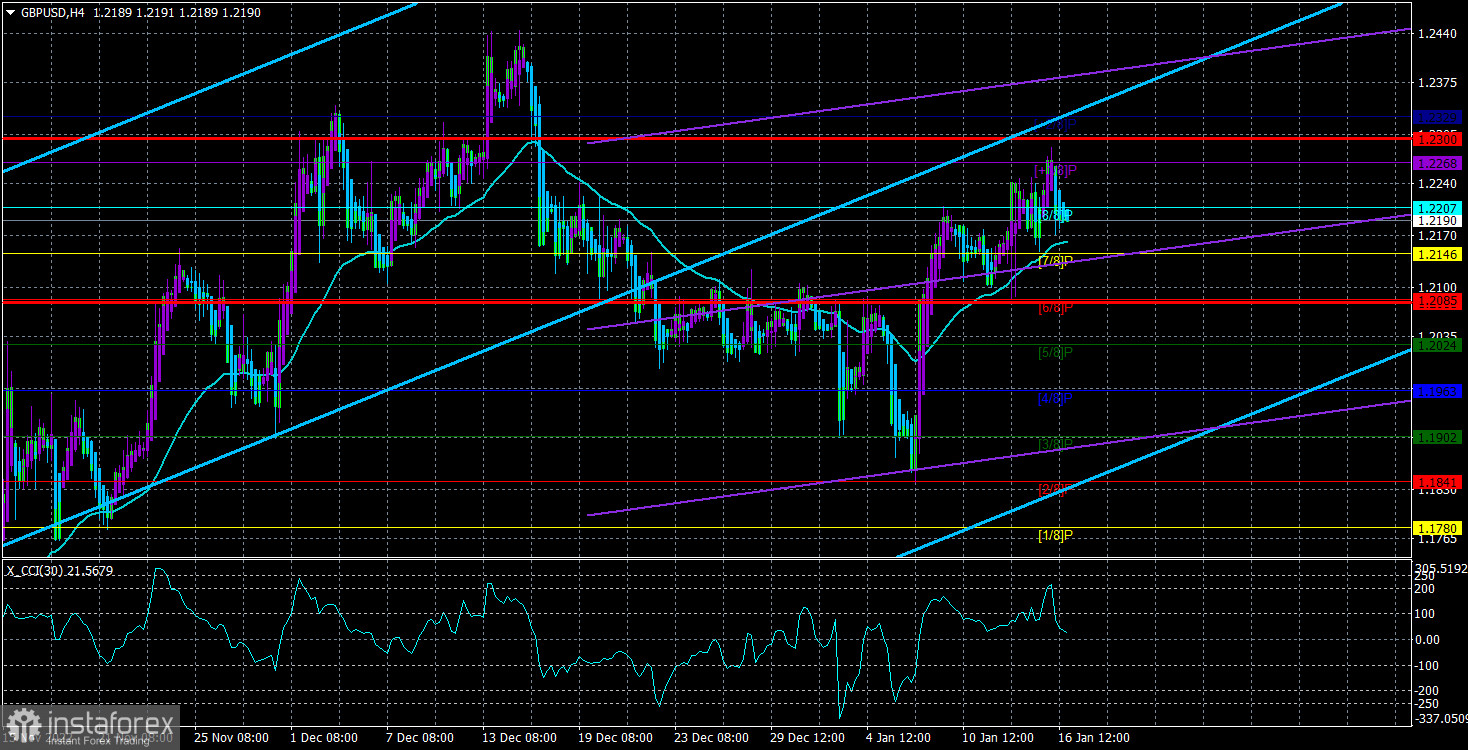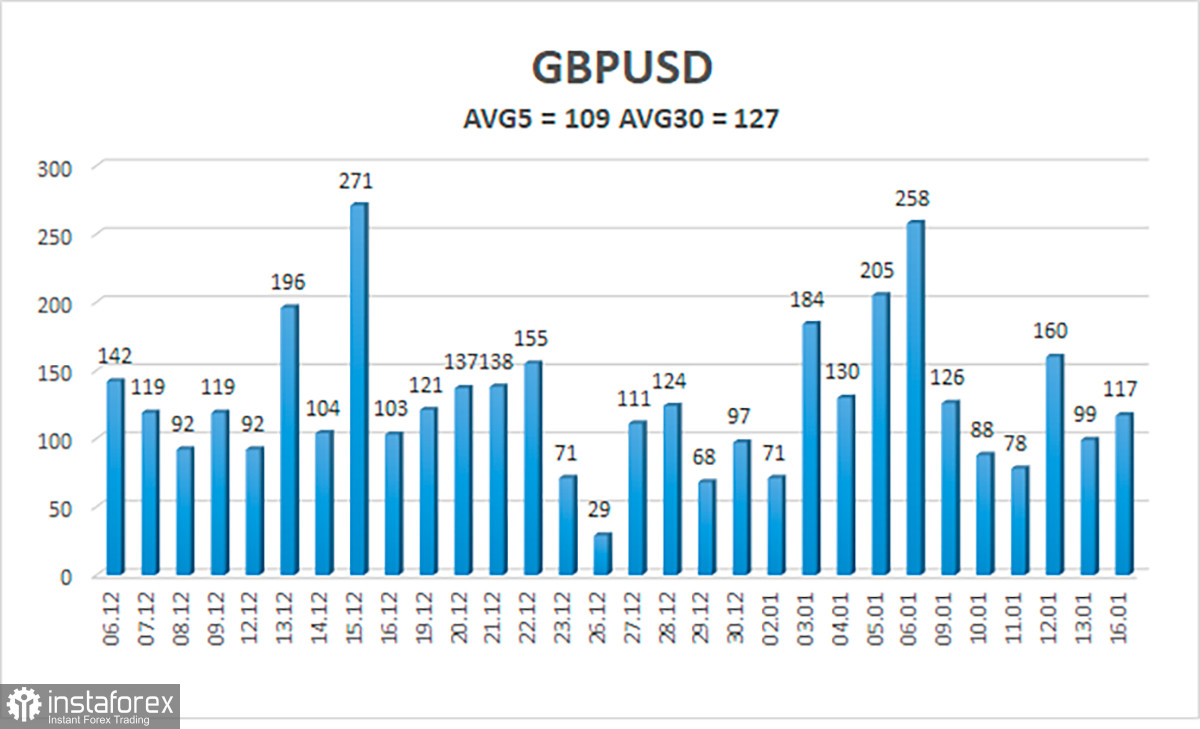
On Monday, the GBP/USD currency pair tested the Murray level of "+1/8"-1.2268, bounced off of it, and started a correction to the moving average line. Due to the lack of unidirectional movement on Monday, macroeconomic and fundamental backdrops were completely absent. Now that the pound/dollar pair may attempt to break below the moving average line, it is not worthwhile to sell the pair until at least some sell signs arise. However, because all trend indicators are still pointing upwards. Remember that we anticipate a significant drop in the pound downward. This adjustment's initial round can be regarded as fixed; a second, identical correction is now required. The Bank of England cannot hike the key rate "to the bitter end," thus this is merely a basic theory based on that reality. It is currently 3.5% and is expected to increase to 4% in early February, however many analysts already anticipate a slowing in the Bank of England's tightening rate. If this occurs at the following meeting, the pound will have the justification it needs to decline because two successive slowdowns in the pace of tightening with inflation still near peaks are not an effort to combat inflation.
Also, take note that a report on consumer prices for December will be released in the UK this week (tomorrow). Up to a maximum of 10.5%, analysts have not yet predicted a significant slowdown as a result of it. Of course, the prognosis might not be accurate, but you still have to pay attention to it. Recall that numerous specialists have frequently predicted that the UK's inflation rate will remain high throughout 2023. It is already widely believed that the Bank of England will increase the rate to 4.25–4.5% and then halt. The British pound is not more upbeat as a result of all this.
The "Northern Ireland Protocol" talks are still going on, but very slowly.
News regarding the subject that everyone has long since forgotten has arrived in the interim. London and Brussels claimed that the talks on the "Northern Ireland Protocol" had made some progress. It was claimed that a database of commodities shipping from Britain to Northern Ireland had been agreed upon by the bloc and the kingdom. Maros Sefcovic and James Cleverley stated that this agreement is "critically vital" and "allows us to start a new branch of conversations and discussions on an urgent subject," even though we can't assess the extent of progress on it.
The conflict currently centers on two issues. The first involves declaring and clearing items for customs before they are sent to Northern Ireland. The second is what the European Court does when there are disagreements. Remember that a hard border between the EU and the UK that also runs between Northern Ireland and Ireland would result after Brexit. There is no doubt that a new, terrible conflict, similar to the one that raged for nearly 30 years in the previous century, will start if a border is established between the two Irish peoples. As a result, it was decided to conduct all customs checks at the ports of Northern Ireland and Britain rather than build a hard border. However, numerous political parties in Northern Ireland expressed dissatisfaction with these judgments, claiming over and again that Northern Irish people continue to deal with document control and bureaucracy in the customs system. As a result, London declared last year that it is prepared to unilaterally withdraw from the Brexit agreement if the contentious problems are not handled (i.e., the European Union would not budge on these matters). Progress is still being made right now, which is already good.
Right now, it's unlikely that the Brexit debate will have a substantial effect on currencies. Gas prices, for instance, which continue to drop everywhere and may cause a decline in inflation when combined with dropping oil prices, are far more interesting. Again, given that an "energy crisis" could develop in Europe, the impending inflation numbers for the EU and the UK are highly intriguing.

Over the previous five trading days, the GBP/USD pair has experienced an average volatility of 109 points. This figure is "high" for the dollar/pound exchange rate. As a result, on Tuesday, January 17, we anticipate movement that is constrained by the levels of 1.2081 and 1.2300. A potential continuation of the upward rise will be indicated by the Heiken Ashi indication turning back to the top.
Nearest levels of support
S1 – 1.2146
S2 – 1.2085
S3 – 1.2024
Nearest levels of resistance
R1 – 1.2207
R2 – 1.2268
R3 – 1.2329
Trading Suggestions:
In the 4-hour timeframe, the GBP/USD pair is attempting to go higher. Therefore, in the event of a new upward reversal of the Heiken Ashi indicator, we can now contemplate new long positions with goals of 1.2268 and 1.2300. If the price is firmly anchored below the moving average, short trades can be opened with goals of 1.2085 and 1.2024.
Explanations for the illustrations:
Channels for linear regression - allow us to identify the present trend. The trend is now strong if they are both moving in the same direction.
Moving average line (settings 20.0, smoothed): This indicator identifies the current short-term trend and the trading direction.
Murray levels serve as the starting point for adjustments and movements.
Based on current volatility indicators, volatility levels (red lines) represent the expected price channel in which the pair will trade the following day.
A trend reversal in the opposite direction is imminent when the CCI indicator crosses into the overbought (above +250) or oversold (below -250) zones.





















